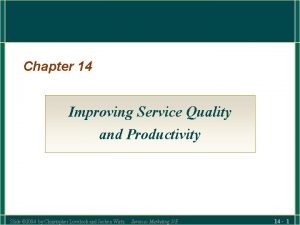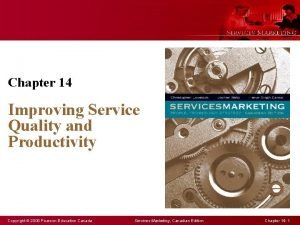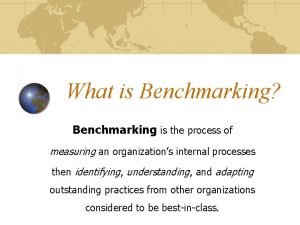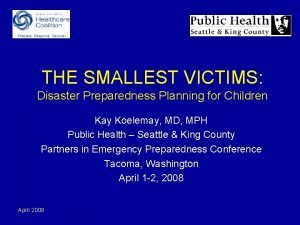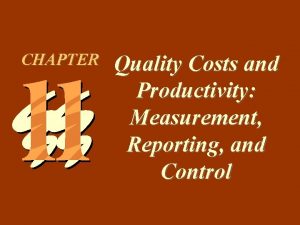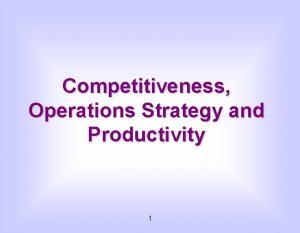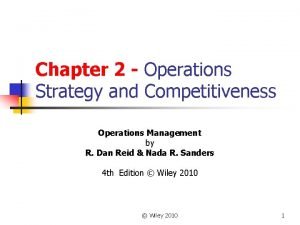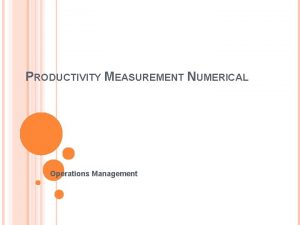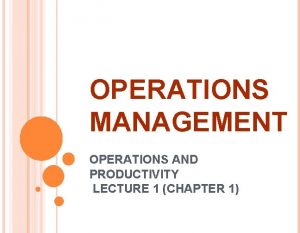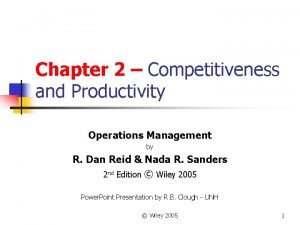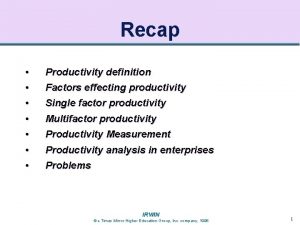Productivity and Quality Management Ninth Lecture Summary Productivity





















































- Slides: 53



Productivity and Quality Management Ninth Lecture

Summary • Productivity indices help us to evaluate economic performance and the quality of social and economic policies. • Productivity Analysis helps identify factors affecting income and investment distribution within different economic sectors, and helps to determine priorities in decision making. • In enterprise, productivity is measured to help analyse effectiveness and efficiency. • Its measurement can stimulate operational improvement

Summary • Productivity Appraisal Methods • Productivity measurement in – Services – Government – Organizations

PERFORMANCE AND PRODUCTIVITY IN NON-PROFIT ORGANIZATIONS

Non-Profit Organizations • Whether the matter is about welfare or warfare, economic development or health, many public and nonprofit agencies continue to find ways of getting the job done. • They take on new challenges helping their communities to move forward, and thereby make important, positive differences that affect the lives of their clients or citizens

Objectives • How do public and nonprofit organizations produce high performance results? • What processes do they use? • How can organizations improve themselves? • This lecture examines the strategies and tactics used by senior, midlevel, and supervisory managers

Role of Managers • These managers are key actors in the processes that their agencies use and the results that agencies produce. • These managers bring mandates to life; they harness and transform the resources (economic, political, professional, etc. ) of their agencies and communities into actual results. • When public agencies win awards for best customer service or use information technology in innovative ways, one can be sure that their managers have played a key role.

PERFORMANCE

Definition of Performance • Performance is defined as the effective and efficient use of resources to achieve results. • Effectiveness is defined as the level of results; for example, the number of arrests made by police officers, the number of welfare clients who find employment after being counseled by case workers, or the amount of money raised through fund-raisers

What is performance? • Performance is about keeping public and nonprofit organizations up-to-date, vibrant, and relevant to society. • It is about ensuring that agency programs and policies connect with the important challenges that people, communities, and the nation face. • Schools need to teach children well, military procurement programs need to provide military personnel with the weapons and combat gear that they need, and environmental protection agencies should work to safeguard our natural heritage

Performance in Public and Non-profit Organizations • Public and nonprofit organizations significantly affect, and have great potential to improve, the lives of citizens and communities in such areas as public safety, transportation, parks and recreation, economic development, education, housing, public health, environmental management, space exploration, social services, and more. • In each of these areas there is interest, and sometimes very great interest, in ensuring that public and nonprofit organizations perform well and help society to move forward.

SOME REASONS FOR PERFORMANCE IMPROVEMENT

Why Perform? • Performance matters in many different ways. • By engaging in and ensuring performance, agencies and their managers contribute to the welfare of society, which, in turn, increases public trust in its public and nonprofit organizations. • Performance helps connect organizations with the concerns of their stakeholders. • Modern societies require effective public and nonprofit organizations, and those who contribute to performance also contribute to improving society.

Why Perform? • For those working in public and nonprofit programs, the need to ensure performance can provide an important source of motivation and professional satisfaction. • There are many reasons for emphasizing performance as part of the professional outlook of managers and their employees. • For example, it is consistently supported by many professional associations, which state personal commitment to excellence as an expectation and even an ethical standard for their members.

Why Perform? • Performance can provide a sense of purpose and intrinsic satisfaction that is not contingent on external events. • When new managers with a strong, personal commitment to performance join an agency, new performance efforts are often in the air. • Not surprisingly, studies of high performing agencies find that these organizations often adapt to change faster and better than others because of their internal processes and the commitment of their managers and employees

Some Reasons for Performance Improvement • External relations • Increasing trust with external stakeholders • Getting organizations to be more responsive to clients • Improving communications with citizens and elected officials • Increasing the ability to effectively partner with other organizations

Some Reasons for Performance Improvement • Management • Increasing effectiveness of services • Choosing better goals and targets • Reducing administrative overhead costs • Decreasing errors and mistakes • Improving accountability • Increasing efficiency or cost savings • Improving employee motivation and commitment • Increasing advantages from information technology • Getting employees to take responsibility for skill upgrading • Making work teams more productive • Improving the climate of trust in organizations

Some Reasons for Performance Improvement • Marketing and fund-raising • Increasing yields from fund-raising efforts • Identifying new client groups for services • Improving the effectiveness of marketing efforts • Improving the yield from grant proposals

Some Reasons for Performance Improvement • Volunteerism • Reducing turnover among volunteers • Identifying new groups of volunteers • Reducing complaints from supervisors and volunteers • Reducing training time for volunteers

Performance in the Public and Private Sectors • Public, nonprofit, and for-profit organizations vary in their relative emphasis on effectiveness and efficiency. • Nonprofit and for-profit (business) organizations constitute the private sector • Effectiveness often is of paramount importance in the public sector: – for example, the public (and, hence, elected officials) expect 911 emergency services to respond promptly, teachers to teach well, traffic to flow smoothly, museums to be open, space shuttles to fly, environmental toxins to be regulated, and defense systems to work • Although efficiency is important, it is often less important than effectiveness.

Performance in the Public and Private Sectors • the lack of attention to effectiveness can bring severe repercussions to public organizations. • Public organizations that are perceived as having low levels of effectiveness often encounter pressures to increase their workloads

Performance in the Public and Private Sectors • This does not mean that efficiency is unimportant in public organizations. • For example, the cost of environmental regulation, and its impact on business, is clearly an important concern. • Efficient organizations stretch their resources further and thus are more effective

Performance in the Public and Private Sectors • Consensus exists that efficiency is typically a more important goal in the for-profit (business) sector, where success tends to be more singularly defined as profit. • Efficiency improvements are important because they result in cost savings that directly contribute to profitability, competitiveness, and corporate survival

• Many productivity improvement efforts in forprofit organizations focus on applications that increase employee output, reduce inventories, speed up production, and reduce rework. • All of these are designed to increase efficiency and serve business purposes

• Some of these have been adapted by public and nonprofit organizations emphasizing efficiency, especially those that emphasize “quality” in relation to customer responsiveness and producing error-free services. • In some cases, federal agencies have found new ways to improve efficiency and service delivery. • Some agencies, such as the Social Security Administration, have even attained exemplary, award-winning levels of customer service.

• Organizations also differ to the extent that they value equity as an important goal. • For-profit organizations usually have very little commitment to equity, other than avoiding discrimination lawsuits from their employees or clients. • By contrast, public organizations often have great commitment to equity: they must provide services to all citizens, regardless of their ability to pay for such services.

Conclusion • Performance is defined as the effective and efficient use of resources. • Effectiveness is typically of greatest importance in the public sector, • whereas nonprofit organizations often emphasize effectiveness and efficiency in equal measure. • Public sector organizations also value providing services to all populations groups, that is, ensuring equity

Productivity Values

MAJOR PERFORMANCE CHALLENGES

Major Performance Challenges • Improvement opportunities are discussed in the following four areas: (1) better serving external stakeholders’ needs, (2) improving organizational effectiveness and using resources efficiently, (3) improving project management, and (4) increasing productivity through people.

Major Performance Challenges • Performance improvement often begins with a diagnosis of things that the organization is not achieving, and which managers and others think it should. • This is consistent with the strategic perspective of performance improvement

Major Performance Challenges • A gap is experienced between expectations and reality—the promise or hope of what an organization can do is not being met. • Manifestations such as inefficient or shoddy service, cost overruns, low client satisfaction, failure to make key decisions—all indicate things are out of kilter, either a little or a lot • A disquiet or dissatisfaction exists about the status quo—something is not good enough.

Major Performance Challenges • From this awareness of things not quite measuring up (something is seen as “way too much” or “much too little”) begins the search for underlying problems, which eventually leads to the adoption of new goals, and the development of processes to help the organization move toward a more desirable state • Performance goals express the gap between what organizations experience, often undesired, and what they think they would like to experience

Performance Goals • Goals imply, implicitly or explicitly, a standard or vision of how things could be. • Client complaints are a problem only in the presence of a standard or alternate future in which fewer clients complain; otherwise, they are just a statement of fact that people are complaining. • Where there is no standard, there is no discussion about success or improvement. • However, performance goals should not only reflect what can or should be improved, but also a realistic assessment about what can be changed.

MAJOR PERFORMANCE PROBLEMS

Stakeholders • In recent years, organizations are increasingly viewed as “open systems” that thrive through exchanges with their environment: organizations must satisfy the needs of their stakeholders: clients, citizens, elected officials, and community leaders. • When the needs of these stakeholders are met, organizations benefit from increased support for their missions. • However, when their stakeholders’ needs are unmet, organizations suffer the consequences through democratic processes and the loss of clientele. Revenues and appropriations decline. • Each of these implies improvement opportunity

Major Performance Problems • Major stakeholder problems • Typical symptoms of major stakeholder problems: stakeholder complaints, • stakeholder apathy, low levels of stakeholder satisfaction, stakeholders or • community leaders ganging up on the organization

Major Performance Problems • Problem 1: Needs of target groups are not sufficiently met. – Variations: Programs are absent or too small to meet target group needs, programs or policies perform poorly, client groups feel disenfranchised or excluded from decision-making processes, target groups have unrealistic expectations. • Problem 2: Individuals who interact with the agency are dissatisfied. – Variations: Unresponsiveness by agency staff, poor mix of interaction mechanisms, inadequate frontline service. • Problem 3: Citizens, clients, or community leaders are apathetic about the program. – Variations: Inadequate enthusiasm for new programs, inadequate support of agency goals and staff. • Problem 4: Individuals or groups are making politics at the expense of the organization.

Major Performance Problems • Major organizational problems – Typical symptoms of major organizational problems: infighting in units, turf battles across units, efforts that consistently sound right but fail to produce results, perceptions of having too many meetings and not doing enough work, spending too much time managing coordination across units, generating plans that gather dust, excessive budget requests, and de-motivated employees.

Major Performance Problems • Problem 5: The mission of the organization (or program) does not serve important society needs. – Variations: The mission(s) has become outdated, failure to obtain new authority and mandates. • Problem 6: Missions are not being pursued. – Variations: Lack of focus, inadequate program development, the organization as a rudderless ship, poor or inadequate resources (financial, technology/skills, people). • Problem 7: The organization or delivery technology is inefficient. – Variations: Organization does not take advantage of economies of scale, delivery process has too many people or units involved, doing it all in-house, inefficient or ineffective use of information technology, delivery process is not informed by state of art practice, red tape.

Major Performance Problems • Problem 8: Inadequate coordination. – Variations: Coordination omits organizations or departments, coordination is shoddy or incomplete, coordination exists, but the outcome does not serve mission or stakeholder needs. • Problem 9: Communication is unclear, contradictory, or ignored. – Variations: A lack of unitary command, contradictory demands, cultural and interpersonal differences cloud communication, communication is misinterpreted by the command structure. • Problem 10: Rewards do not support mission. – Variations: Rewards or acknowledgement are absent or support other priorities, rewards or consequences encourage perverse behavior.

Organizations • Many performance problems are caused by failure to adhere to basic principles of organizational design. • This can produce symptoms such as infighting, lack of direction, micromanagement, spending too much time on coordination, plans that gather dust, and the inefficient use of or acquisition of resources. • Employee demotivation may occur as a secondary result. • These problems affect programs as well as agencies as a whole.

Projects • When projects are managed poorly, they fall behind schedule, lack relevance, exceed costs, and fail to meet standards, yielding stakeholder dissatisfaction or apathy. • They fail to contribute to the agency’s mission. • Project management is about avoiding these outcomes. • The hallmark of properly managed programs is that they achieve their objectives – (1) on time, – (2) within budget, and – (3) at or above quality and performance specifications.

Major Performance Problems • Major Project Problems – Typical symptoms of project problems: – insufficient relevance, falling behind schedule, not achieving results, going way over budget, and having upset or apathetic clients and other stakeholders.

Major Performance Problems • Problem 11: Inadequate planning. – Variations: Unrealistic goals, misalignment between ends and strategies, resources are poor or inadequate, lack of a contingency strategy. • Problem 12: Inadequate control of execution. – Variations: Not sufficiently knowing the status of projects or events that affect projects, allowing partners and people to get sidetracked. • Problem 13: Lack of satisfaction among clients or stakeholders. – Variations: Clients insufficiently involved, clients’ needs wrongly assumed (see Problem 1).

People • People are key to making organizations work. • When they fail, so too do many organizations and their programs. • People are a critical resource. • Typical symptoms of people problems are people shunning their work, their manager or their coworkers, staff demotivation, formal or informal complaints against a person, projects falling behind, and lack of new programs, successful programs, or program leadership

Major Performance Problems • Major People Problems – Typical symptoms of people problems: people shunning their work, manager, or coworkers, staff demotivation, formal or informal complaints against a person, projects falling behind, lack of new programs, successful programs, or program leadership. – Note: These symptoms are not always caused by people problems. People may show these symptoms when caused by other problems such as poor coordination or red tape.

Major Performance Problems • Problem 14: Values are insufficiently professional. – Variations: Unethical or a-ethical behavior, disinterest in skill development. • Problem 15: Technical skills are lacking. – Variations: Inability to acquire modern skills, avoiding activities that require technical skills, denial that skills are lacking, mediocrity, micromanagement. • Problem 16: Poor social skills. – Variations: Being too confrontational or too accommodating, being impulsive, being closed to constructive criticism or opportunities for growth.

Summary • • Performance and Productivity Public and Private Organizations Some reasons for Performance Major Performance Challenges – Stakeholders – Organizations – Projects – People


Improving Productivity
 Project management lecture notes doc
Project management lecture notes doc 01:640:244 lecture notes - lecture 15: plat, idah, farad
01:640:244 lecture notes - lecture 15: plat, idah, farad Sixth and ninth commandments
Sixth and ninth commandments The sixth and ninth commandments
The sixth and ninth commandments Human anatomy & physiology edition 9
Human anatomy & physiology edition 9 Improving service quality and productivity ppt
Improving service quality and productivity ppt Service quality and productivity
Service quality and productivity Relationship between safety, quality and productivity
Relationship between safety, quality and productivity What is benchmarketing
What is benchmarketing Levels of analysis psychology
Levels of analysis psychology Ninth grade vocabulary
Ninth grade vocabulary Macroeconomics mankiw 9th edition
Macroeconomics mankiw 9th edition General adaptation syndrome
General adaptation syndrome Ramadan is the 9th month
Ramadan is the 9th month William blount 9th grade academy
William blount 9th grade academy Lower ninth ward
Lower ninth ward Social psychology ninth edition
Social psychology ninth edition What is not a classical accompaniment of poulet maryland
What is not a classical accompaniment of poulet maryland Biology ninth edition
Biology ninth edition Child development ninth edition
Child development ninth edition Child development 9th edition
Child development 9th edition Abnormal psychology ronald j comer 9th edition
Abnormal psychology ronald j comer 9th edition Psychology ninth edition in modules
Psychology ninth edition in modules Psychology ninth edition david g myers
Psychology ninth edition david g myers Biology ninth edition
Biology ninth edition Campbell ninth edition
Campbell ninth edition Ninth district pta
Ninth district pta Quality productivity ratio
Quality productivity ratio Contemporary management practices
Contemporary management practices Quality control and quality assurance
Quality control and quality assurance Quality assurance concepts
Quality assurance concepts Competitiveness strategy
Competitiveness strategy Productivity and competitiveness in operations management
Productivity and competitiveness in operations management Productivity and competitiveness in operations management
Productivity and competitiveness in operations management Operations and quality management
Operations and quality management Operations management with total quality management book
Operations management with total quality management book Project planning and management lecture notes ppt
Project planning and management lecture notes ppt Project quality management pmp
Project quality management pmp Pmp gold plating
Pmp gold plating Quality assurance model in nursing
Quality assurance model in nursing Quality improvement vs quality assurance
Quality improvement vs quality assurance Known as the fun uncle of the quality revolution
Known as the fun uncle of the quality revolution Quality is free: the art of making quality certain
Quality is free: the art of making quality certain What is tqm
What is tqm Randy pausch the last lecture summary
Randy pausch the last lecture summary Lecture to a missionary
Lecture to a missionary Multifactor productivity in operations management
Multifactor productivity in operations management Operations and productivity
Operations and productivity Operations management productivity problems
Operations management productivity problems Labor productivity formula
Labor productivity formula Productivity definition in operations management
Productivity definition in operations management Project procurement management lecture notes
Project procurement management lecture notes Strategic management lecture
Strategic management lecture Software project management lecture notes
Software project management lecture notes





